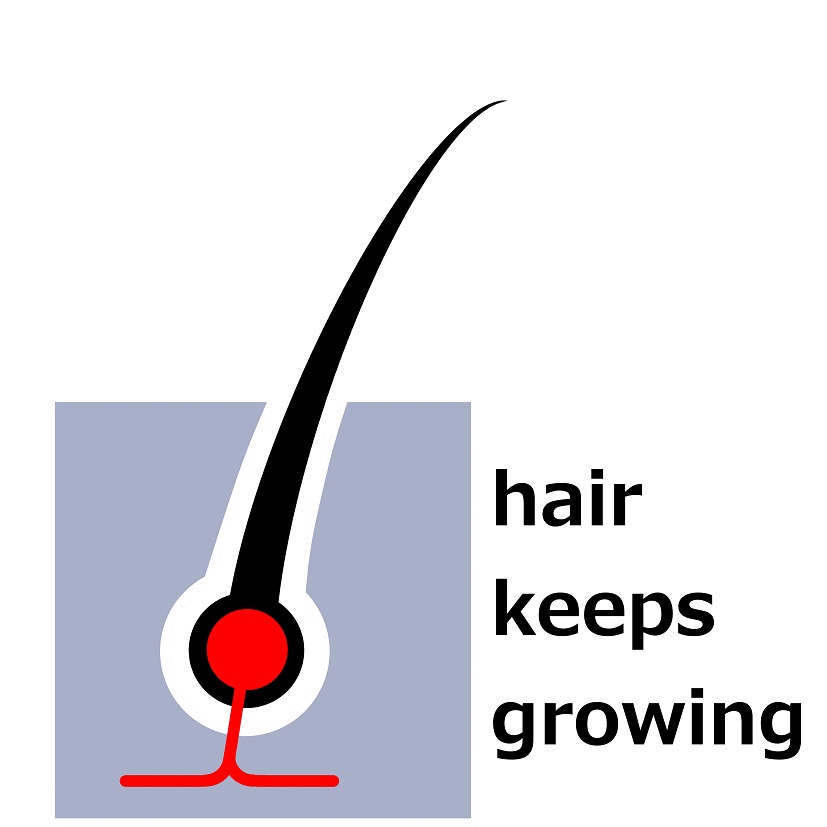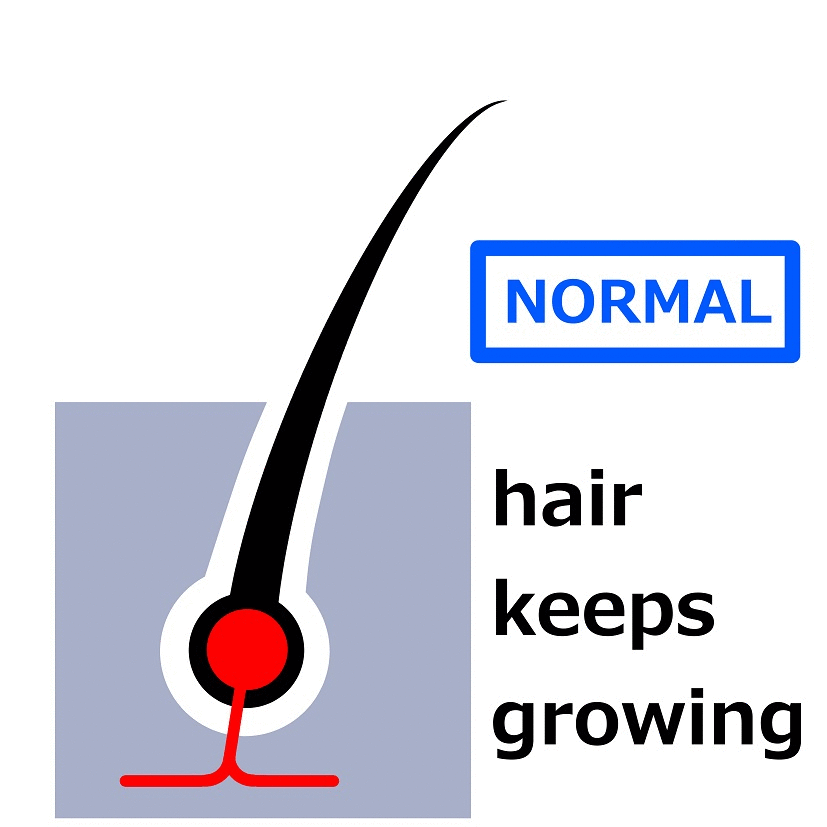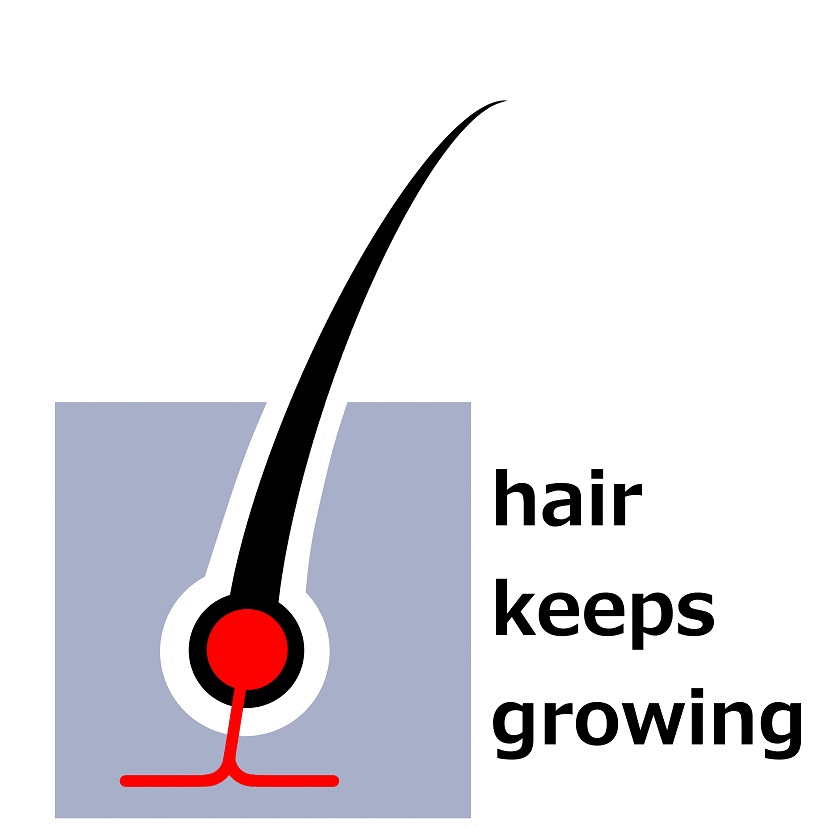Thinning Hair and the Hair Growth Cycle
If you’re starting to notice your hair thinning, it’s only natural to wonder why. Could it be the beginning of male pattern baldness, or is it simply the result of the natural aging process? To better understand why your hair may be getting thinner over time, we first need to look at how your hair grows.
AGA is caused by a shortening of hair growth cycle. Let’s see what a hair growth cycle is, including its relationship with AGA.
What is a hair growth cycle?
Hair grows and regresses every day. It doesn’t feel good to see the hair that has fallen off in the bathroom, but this is a normal phenomenon even for healthy people. Since each hair has a limited lifespan, hair that has continued to grow for a certain period of time will naturally fall off. Each hair follicle is independent and goes through the growth cycle at different times, otherwise all your hair would fall out at once.
The following figure shows the hair growth cycle of a healthy person.
Hair growth cycle stage
The Growing Phase [Approximately 85-90% of the total hair]
The stages of hair growth begin with the growing phase. It’s the longest phase, lasting about 3 to 5 years for the hairs on your head averagely. During this phase, the cells in the root of your hair are most rapidly dividing so more new hair is formed. And your hair follicles are pushing out hairs that will continue to grow until they’re cut or until they reach the end of their lifespan and fall out.
The Transition Phase [Approximately 5% of the total hair]
The next phase is a short transition stage that occurs at the end of the growing phase, and tends to last about 2 to 3 weeks. During this stage, the supply of nutrients from the dermal papilla cells required for hair matrix cell division gradually begins to stop, making it difficult for the hair to grow. About 5 percent of the hairs on your head are in the transition phase at any given time.
The Resting Phase [10-20% of total hair]
After the short transition phase, the resting phase follows. Hairs don’t grow during this phase, but they don’t usually fall out either. During this phase, new hairs start to form in follicles that have just released hairs during the transition phase. And at the end of this phase, the hair strands are released from their follicles and fall out. Then the whole process can begin again.
■the hair growth cycle


What Happens when the Hair Growth Cycle is Disrupted?
Hair loss, hair thinning and problems with hair growth may occur when your growth cycle is disrupted. This can be triggered by conditions such as metabolic imbalances, illness or improper nutrition. But the main cause of thinning hair is AGA.
What is AGA [male pattern baldness]
DHT (dihydrotestosterone) is a substance that disturbs the normal hair growth cycle and causes thinning hair. This is produced by binding testosterone, which is present in male hormones, to a substance called 5α-reductase (types I and II) distributed in the scalp. By binding this DHT to the androgen receptor present on the dermal papilla cells, it shortens the growing phase in the hair growth cycle, resulting in the progression of thinning hair. (DHT has various important functions such as promoting the development of external genitalia during the fetal period of boys, but it causes AGA and benign prostatic hyperplasia after puberty.)
■the hair growth cycle [AGA]


Treatment of AGA [male pattern baldness]
To stop the progression of AGA, it is essential to suppress DHT, which is responsible for causing AGA. Finasteride, the active ingredient of Propecia inhibits the action of 5α-reductase type II, which promotes the conversion of testosterone to DHT. This action suppresses the production of DHT, resulting in improvement of thinning hair.
In addition, Zagallo has been approved as a next-generation AGA medication following Propecia, but this active ingredient “dutasteride” can be expected to have a stronger effect by suppressing the actions of both 5α-reductase types I and II. And when comparing the two, medical professionals found that dutasteride showed better results and usually worked faster than finasteride.
■hair growth cycle [taking finasteride]


Causes of thinning hair except for AGA
Disorders in lifestyle
・ Sleep deprivation → The secretion of growth hormone required for hair production is delayed.
・ Excessive smoking → Vasoconstriction caused by the action of nicotine reduces blood flow to the scalp.
・ Excessive drinking → Amino acids required for alcohol decomposition will not be distributed to hair.
・ Insufficient nutrition → The lack of nutrition required for hair.
・ Stress → Sympathetic nerves are stimulated and blood vessels in the scalp contract.
・ Improper hair care → adverse effects such as some shampoo that is too irritating.
Skin diseases, etc.
・ Alopecia areata → A type of autoimmune disease that suddenly causes some hair to fall out.
・ Seborrheic alopecia → Pore is clogged with excess sebum, and hair loss increases.
・ Mechanical alopecia → The hairline recedes by tightening in a certain direction.
・ Trichotillomania→ A symptom of pulling out your own hair.
・ Hair loss caused by drugs or anti-cancer drugs → Side effects caused by drugs.
AGA progresses if left untreated. You can improve your lifestyle habits on your own, but you should seek medical specialists to treat DHT problems. At our hospital, Propecia has been prescribing to more than 70,000 registered patients since it was approved by authority in Japan (2005). This medicine should be taken steadily on a daily and yearly basis. If you have any concerns, please do not hesitate to visit us.
ED・AGA related pages
Propecia
finasteride
Zagallo
dutasteride
FAQ about AGA treatment
minoxidil solution
carpronium chloride solution
Viagra
sildenafil



